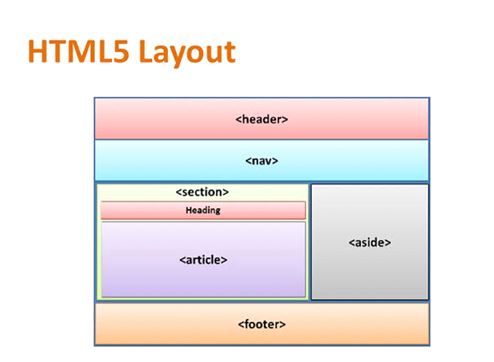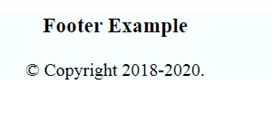HTML Layout
HTML layouts provide a way to arrange web pages in well-mannered, well-structured, and responsive ( all devices) form or we can say that HTML layout specifies a way in which the web pages can be arranged.
Use CSS and JAVASCRIPT based frameworks for creating layouts for responsive ( all devices) and dynamic website designing.

Different HTML5 elements:
- <header>: Header for a document or a section.
- <nav>: Container for navigation links
- <section>: Section in a document
- <article>: Independent self-contained article
- <aside>: Content aside from the content (like a sidebar)
- <footer>: Footer for a document or a section
- <details>: Additional details
- <summary>: Heading for the <details> element
HTML <header>:
The <header> element is used to create the header section of web pages. The header contains the introductory content, heading element, logo, or icon for the webpage.
Example:
<!DOCTYPE html>
<html>
<head>
<title>First Webpage</title>
</head>
<body>
<header style="background-color: #303030; height: 80px;width: 100%">
<h1 style="font-size: 30px; color: white;text-align: center; padding-top: 15px;">Welcome to MyFirstWebpage</h1>
</header>
</body>
</html>
OUTPUT:

HTML <nav>:
The <nav> elements is a container for the main block of navigation links. It can contain links for the same page or for other pages.
Example:
<!DOCTYPE html>
<html>
<head>
<style>
li{ display: inline-block;
padding: 10px}
</style>
</head>
<body>
<nav style="background-color:#bcdeef;">
<h1 style="text-align: center;">Navgation Links</h1>
<ul>
<li><a href="#">link1</a></li>
<li><a href="#">link2</a></li>
<li><a href="#">link3</a></li>
<li><a href="#">link4</a></li>
</ul>
</nav>
</body>
</html>
OUTPUT:

HTML <section>:
HTML <section> elements represent a separate section of a web page which contains related element grouped together. It can contain text, images, tables, videos, etc.
Example:
<!DOCTYPE html>
<html>
<head>
<title>Page Section</title>
</head>
<body>
<section style="background-color:#ff7f50; width: 100%; border: 1px solid black;">
<h2>Introduction to HTML</h2>
<p>HTML is a markup language ...................,,,,,,,,,,,,,,</p>
</section>
</body>
</html>
OUTPUT:

HTML <article>:
The HTML article tag is used to contain a self-contained article such as a big story, huge article, etc.
Example:
<!DOCTYPE html>
<html>
<head>
<title>Article Example</title>
</head>
<body>
<article style="width: 100%; border:2px solid black; background-color: #fff0f5;">
<h2>History of I2tutorials</h2>
<p>Write your content here for the history of I2 tutorials</p>
</article>
</body>
</html>
OUTPUT:

HTML <aside>:
HTML <aside> provide aside content related to primary content. The <aside> content must be related to the primary content. It can function as a sidebar for the main content of the web page or website.
Example:
<!DOCTYPE html>
<html>
<head>
<title>Aside Example</title>
</head>
<body>
<aside style="background-color:#d9d9d9">
<h2>Aside information</h2>
<p>This conatins information which will ,,,,,,,,,,,,,,</p>
</aside>
</body>
</html>
OUTPUT:

HTML <footer>:
HTML <footer> element defines the footer for that document or web page. It mostly contains information about the author, copyright, other links, etc.
Example:
<!DOCTYPE html>
<html>
<head>
<title>Footer Section</title>
</head>
<body>
<footer style="background-color:#f0f8ff; width: 100%; text-align: center;">
<h3>Footer Example</h3>
<p>© Copyright 2018-2020. </p>
</footer>
</body>
</html>
OUTPUT:

HTML <details>:
HTML <details> element is used to add extra details about the web page and use can hide or show the details as per requirement.
Example:
<!DOCTYPE html>
<html>
<head>
<title>Deatils element</title>
</head>
<body>
<details style="background-color: #f5deb3">
<summary>This is visible section: click to show other details</summary>
<p>This section only shows if user want to see it. </p>
</details>
</body>
</html>
OUTPUT:

HTML <summary>:
HTML <summary> element is used with the <details> element in a web page or website and it is used as summary, captions about the content of <details> element.
Example:
<!DOCTYPE html>
<html>
<head>
<title>Summary Example</title>
</head>
<body>
<details>
<summary>HTML is markup language for?</summary>
<p style="color: blue; font-size: 20px;">Hypertext Markup Language</p>
</details>
</body>
</html>
OUTPUT:

